Almost 200 years ago, the young Charles Darwin came up to Christ’s College to begin a comprehensive theological education. In what could be considered the most productive procrastination in history, he instead spent much of his time in Cambridge attending lectures in the natural sciences, under the mentorship of John Stevens Henslow and Adam Sedgwick. On the subsequent Beagle voyage, Darwin undertook botanic and zoological studies but, in light of his seminal contribution to evolutionary biology, history often forgets that he also produced a substantial body of geological research.
Today, Christ’s College celebrates the role that it played in Darwin’s early life by facilitating scientific research on the Galápagos Islands. I currently hold the Charles Darwin and Galápagos Islands Fund Junior Research Fellowship and it is testament to Darwin’s broad-ranging interests that I am a geologist.
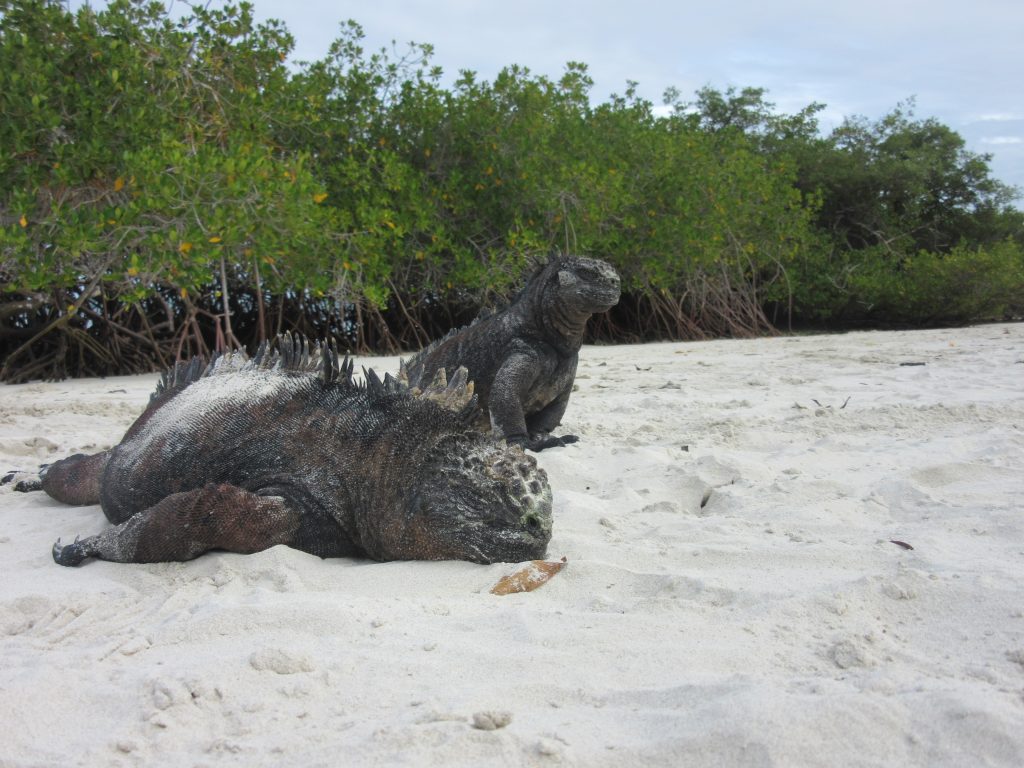
My research is in volcanology and is focussed on using the chemical fingerprints of erupted rocks to understand the processes that occur in magma chambers beneath the Earth’s surface. Currently, I am applying state-of-the-art analytical techniques to Galápagos volcanoes, in an attempt to understand their sub-surface architecture and the eruption triggers. Despite Darwin’s early interest in the chemical variability of rocks from the Galápagos Islands, very little is known about magma chamber processes in the archipelago, particularly compared to regions with similar volcanic activity such as Iceland and Hawaii. Understanding these processes is important, not only because of the ecological threat posed by frequently-active Galápagos volcanoes, but also because comparison of eruptions on the different islands may hold important clues to understanding magmatic processes globally. To address this, I recently led a month-long scientific expedition to Galápagos, with the aim of collecting a range of lava samples that were erupted at different times in distinct parts of the archipelago. The trip was largely financed by the Christ’s College Galápagos Islands Fund, with additional support from the Geological Society of London, the Royal Geographical Society and the Mineralogical Society of Great Britain and Ireland.
‘The sinking of crystals through a viscid substance like molten rock […] is worthy of further consideration, as throwing light on the separation of the trachytic and basaltic series of lavas.’
Charles Darwin (Geological Observations on the Volcanic Islands, 1844)
The expedition team was international, with wide-ranging academic interests. In addition to myself, the Cambridge contingent included Dr Sally Gibson (a University lecturer) and Matthew Gleeson (a PhD student at Jesus College). Sally and Matt specialise in the chemistry of the Earth’s mantle and are undertaking research into how this varies spatially between different parts of the Galápagos Archipelago. We were joined by Dr Benjamin Bernard and Antonio Proaño Altamirano from Escuela Politécnica Nacional in Quito (Ecuador), who are interested in the physical morphology of lava deposits and are directly involved in monitoring Galápagos volcanoes to detect signals that might precede future eruptions. The final team member was Wilson Villamar, a Galápagos National Park ranger.
The Galápagos Islands are located approximately 1,000 km off the west coast of Ecuador. Although there are small towns on the islands, the volcanoes that we needed to access were in remote parts of the archipelago, well away from these population centres. Carrying out fieldwork in such a remote location is logistically challenging and required careful preparation: injuries would not only risk prematurely ending the trip but could also cause a serious evacuation challenge. To mitigate this, we hired M/V Pirata (literally translated as the ‘Pirate’) – a retrofitted early 20th century schooner. It is not the most luxurious boat in Galápagos, but it is manned by a highly experienced crew, intimately familiar with the obscure parts of the archipelago frequented by visiting scientists. Sleeping on Pirata was often challenging, particularly in rough seas, with all six team members closely packed into bunk beds in a cabin at the back of the boat. However, the captain prides himself on employing an excellent chef, who produced exceptional food with only two unstable hob rings and a tiny oven – nothing compares to freshly caught Galápagos fish after a long day in the field.
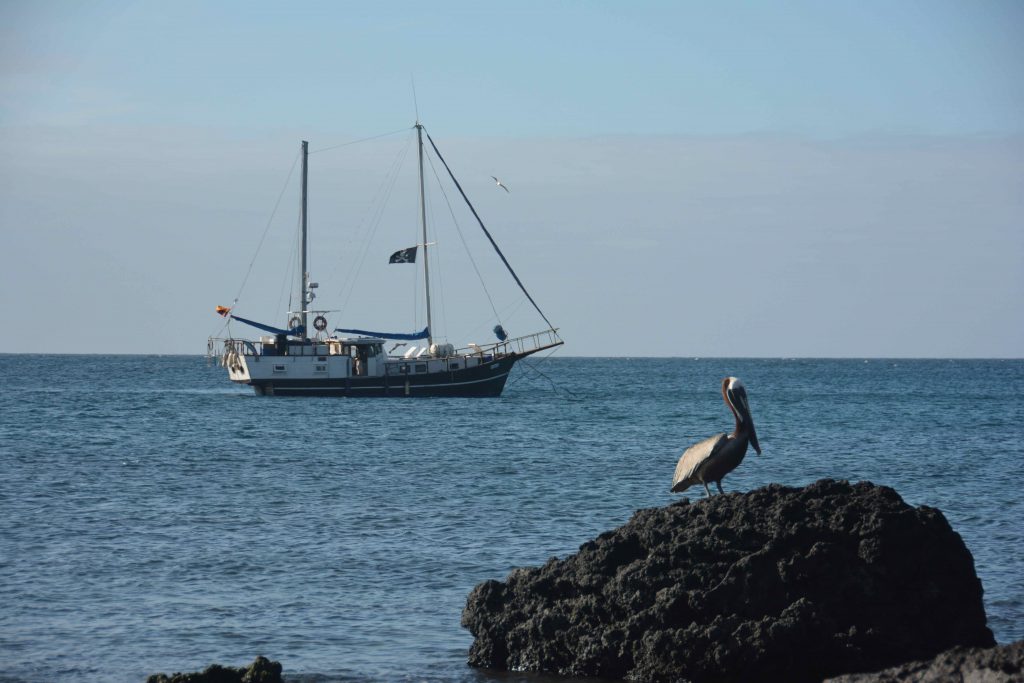
Before leaving the main towns on Galápagos, all scientists must go through a thorough quarantine. All clothes, bags and boots are cleaned, sterilised and put in a freezer for at least 48 hours, to remove seeds and kill any bugs. As a UNESCO world heritage site, the preservation of the island’s ecosystem is of paramount importance.
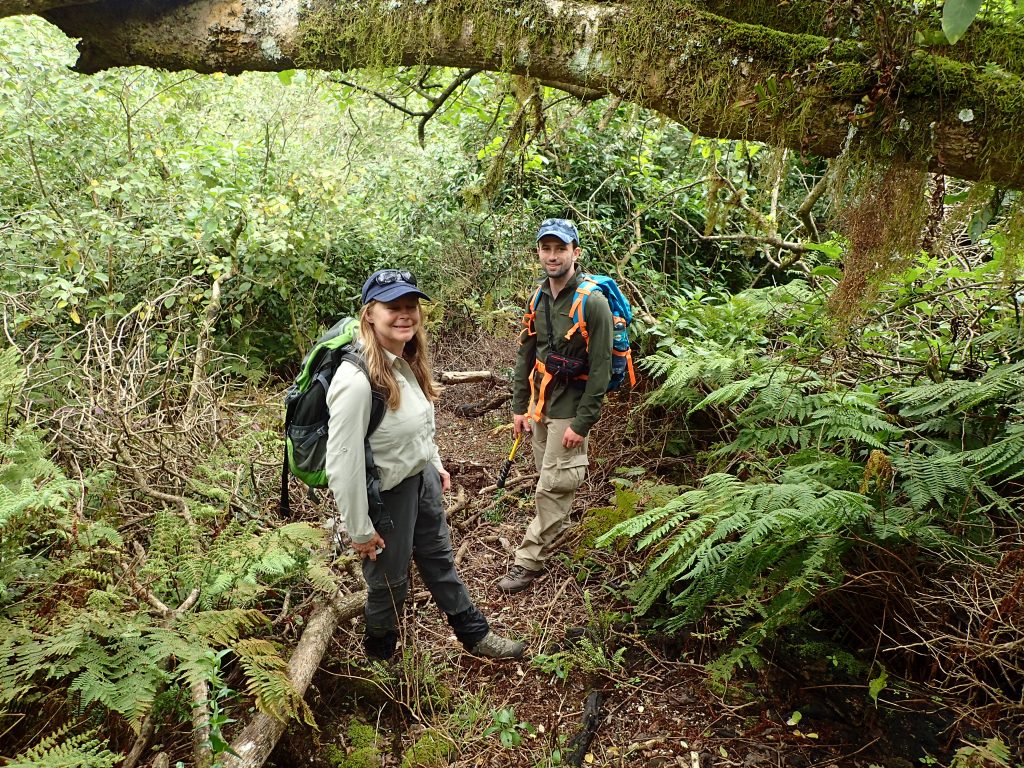
Our first stop was the small island of Floreana in the southeast of the archipelago. Floreana is one of the oldest islands in Galápagos and is made up of numerous small volcanic cones, at least one of which (Cerro Pajas) Darwin records climbing when he visited the island on 27 September 1835. There has been no volcanic activity on Floreana for thousands of years, and the island is consequently covered in jungle-like equatorial vegetation. Tourists visit Cormorant Point on the north coast, where they can see a flock of wild flamingos that live in an isolated brackish lagoon. Elsewhere on the island there are thriving colonies of seals, sea turtles, enormous marine iguana and other exotic birds. We spent our time on Floreana sampling from the old volcanic cones and particularly looking for blocks of crystalline material, which form deep in the Earth’s crust but were exhumed in violent volcanic eruptions. As access is so restricted, there are no paths in the remote parts of the Galápagos Islands and sampling was difficult, requiring a machete to cut our way through dense vegetation in hot and humid conditions.
‘It is long since the Lava streams which form the lower parts of the Island flowed from any of these Craters: Hence we have a smoother surface, a more abundant soil, & more fertile vegetation.’
Charles Darwin (referring to Floreana Island, Beagle Diary, 26-27 September 1835)
After visiting each island, we had to go back through quarantine to avoid spreading the endemic flora and fauna between our different fieldwork locations. Our next stop was Volcan Wolf, on Isabella Island, in the west of the archipelago. In contrast with Floreana, Isabella is one of the youngest islands in Galápagos and, rather than countless small cones, the island is comprised of six very large volcanoes with gently sloping flanks. Volcan Wolf is the most northerly of these and is located directly on the equator. At the time of the fieldtrip, it was the most recently active volcano in Galápagos, having last erupted in May 2015 (a subsequent eruption occurred on Fernandina Island in September this year). We sampled along the east flank of the volcano, which is covered by extremely fresh lava flows. These form a barren landscape, more closely resembling the surface of Mars than the dense vegetation of Floreana. A flock of flightless cormorants were almost the only living thing we saw during a week on the volcano. Here, our objective was to collect rock samples from as many recent lavas as possible, and crucially to access the new flows that formed in 2015. Although there was no need for the machete, working here was no less physically demanding – hiking all day in direct sunlight was exhausting and the fresh lavas are razor sharp, constantly shifting as you walk on them. It was challenging terrain to say the least!
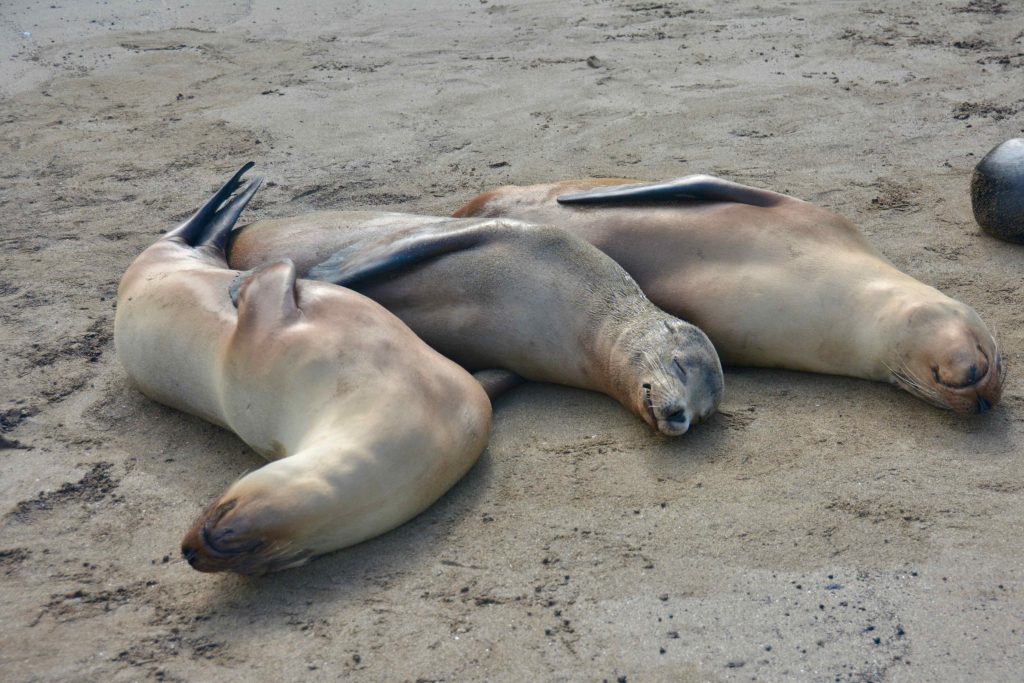
Our final fieldwork location was Volcan Sierra Negra in the south of Isabella Island. Unlike Volcan Wolf, this volcano is close to a population centre (the town of Puerto Villamil) and is a popular tourists spot, where visitors can observe the enormous (9 km diameter) volcanic crater at the summit. Sierra Negra was last active in 2005, and here we were able to hike to the eruption vent. This allowed us to sample glassy ash and scoria (i.e. black pumice), which were quenched as they were expelled into the atmosphere during a particularly violent phase of the eruption.
The trip was a great success, having acquired almost 100 kg of rock samples. These will provide a foundation for many years of future scientific interrogation. We were hugely privileged to gain access to remote parts of the Galápagos Archipelago, which is truly a gem of the natural world. The abundance and diversity of life on the islands is staggering and I returned to Cambridge with a deep appreciation of the need to preserve one of the Earth’s last bastions of untouched biodiversity. I hope that my own research into volcanic eruption triggers and hazard mitigation can contribute to this. But now, sitting in Christ’s College with a picture of Darwin on my wall, I can’t help but be inspired by the fortitude of that young man who left the College and toiled for years in extreme environments to change the way we see the world forever.
Mike Stock Junior Research Fellow
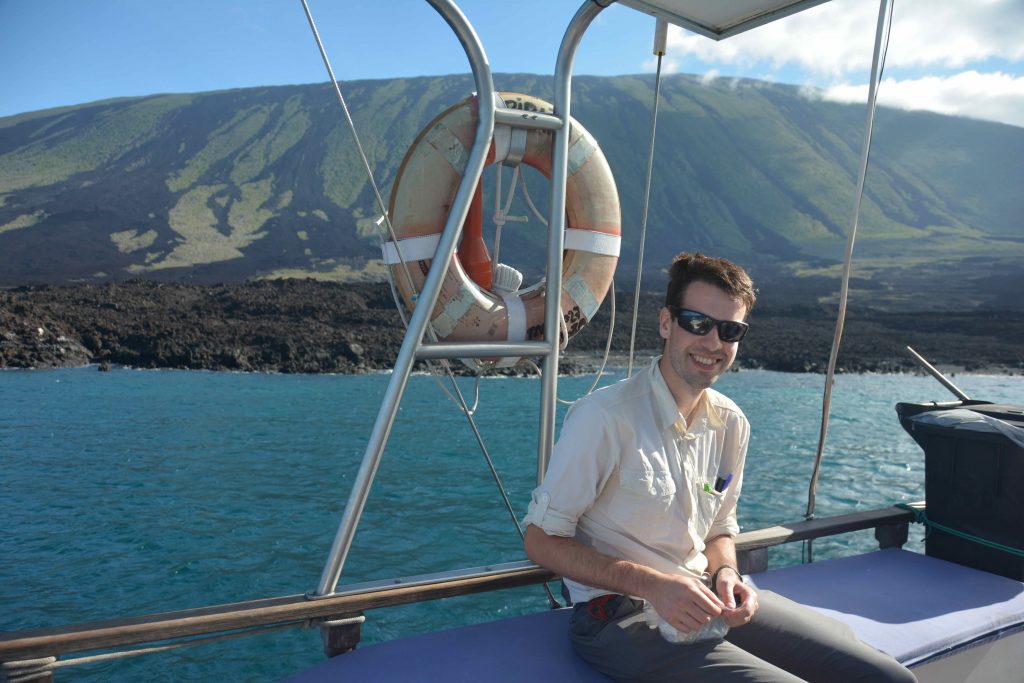
Featured image: the expedition team standing directly on the equator, with Volcan Wolf in the background. © SA Gibson


